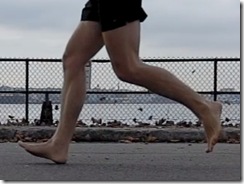 Yesterday I posted a few still shots captured from a video I took at the NYC Barefoot Run. Today I add a a few video clips showing a sample of runners from the event – mixture of barefoot and several Vibram Fivefingers runners (as well as a few other things).
Yesterday I posted a few still shots captured from a video I took at the NYC Barefoot Run. Today I add a a few video clips showing a sample of runners from the event – mixture of barefoot and several Vibram Fivefingers runners (as well as a few other things).
Once again, it’s hard to know if these runners were forcing their stride or not, but certainly to compare the barefooters to the Vibram runners suggests again that just putting on a pair of Fivefingers is not necessarily going to cause you to stop heel striking. However, running in barefoot-style shoes may change your stride in other, perhaps more subtle ways. Furthermore, some people do in fact heel strike when barefoot – how long they continue to do so is unknown, but the individual in the photograph above was among the group on their second 2-mile loop around Governor’s Island (don’t know if he started with them or not).
I have not quantified patterns from the video yet, but it looks to me like the percentage of forefoot strikers is higher among barefooters than among wearers of Fivefingers, I’ll leave it up to you to ponder/speculate on why that might be the case.
Make the videos below full-screen for best viewing, quality is somewhat degraded from the original during file conversion and upload to YouTube. I have also cropped the originals to mask the identity of the runners.
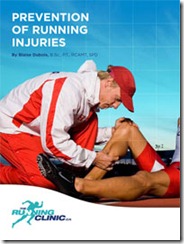
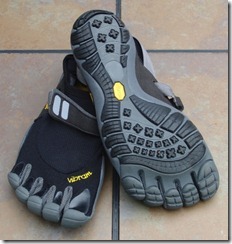
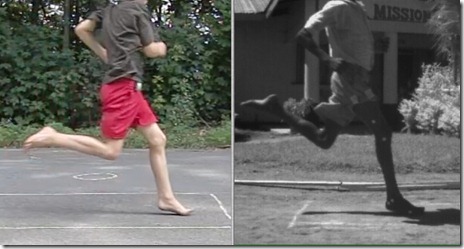

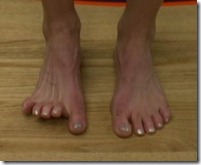














Question I had this morning upon emerging from the shower: does shoe/foot size have any impact on prevalence of forefoot/midfoot/heel strike? Do you have any data showing a correlation? In other words, does the size of the lever (the length between the forefoot to the heel) play a factor in whether a person is inclined to strike differently while running? Extended further, does length of tibia and length of femur have anything to do with foot strike preference? Or, perhaps its a ratio thing: femur length:torso length (comparing running biomechanics of someone with short legs & long torso vs. long legs & short torso, etc.)?
Great question, and I have no idea what the answer is!
Your post resonates strongly with my recent experience… I’ve been running barefoot and in V5Fs for the last year and a half or so. I have some lower back problems from an almost herniated disk, so I haven’t logged as many miles as I wish I had. But there’s close to 1000 Km in my log, probably 70% barefoot, the rest in V5Fs. So I was convinced that I had well established mechanics… until last week I took my high speed camera and filmed myself. And I happen to be one of those barefoot heel strikers. Not by much, I’m kind of close to midfoot, but there really is no discussion:
link to youtube.com…
That’s nuts.
I found the baggy shorts runner that is centered at :28 sec interesting.
Watch how he almost swings his foot around the forward line to land on the outside part of the foot and then roll in.
This is exactly what used to give me itb problems before I figured it out.
Clearly running barefoot, in and of itself does not give one perfect form.
Fascinating post and video to watch – thanks for posting it.
This is SteveF from other replies, but I am not given the option to login from the iPad.
I think there are too many variables to focus on any one – including foot placement during landing. A mild heel strike, for example, may be more efficient for a given runners biomechanics, or a given running circumstance. I don’t think anyone would run an ultra on their forefoot, for example, regardless of footwear (or lack thereof). Frankly, I think most people would transition to more minimal footwear (however we define that) more easily if they’d obsess less about form. Just relax, pick your feet up, and let your body figure it out. Neurosis is not efficient; and more importantly, in ruins the enjoyment of running.
I totally agree. Obsession about foot strike can be counterproductive, and it seems clear that lots of people have a mild heel strike in minimal shoes and do just fine. Other factors are probably more important.
I agree with your points re variation in form. However, a proper forefoot strike isn’t neccesarily strained and barely works your calf. At the end of my last marathon in Vibrams I was dead-dog tired and on the verge of massive cramping but still easily forefoot striking. When I run barefoot I feel my calf tensing just enough to hold my foot in place while my tendons do all the work. It’s often newly transitioned runners that land forcefully and consciously on the forefoot, thus straining their calf muscle.
I’ve noticed some crazy foot strikes amongst the runners here in Monterey. Specifically the military officers I work with. Many of them have gone to VFFs and other minimal footwear, but think I’m nuts for occasionally running barefoot. Long story short, their form is just awful and they continually bang their heels into the ground. My question is “How long can one do this?” It looks absolutely horrible, painful and damaging. Sort of curious how long that could possibly last.
I tend to think there are 3 main factors involved in efficiency of stride: foot strike, up and down motion and stride length. A hard heel landing is clearly inefficient since it alters a smooth forward motion. Bouncing up and down is wastes energy that could be directed toward moving forward. Stride length seems to be a function of the first two. Shorter striders tend to be mid or fore-foot strikers with very little up and down motion. Longer striders tend to be heel strikers with pronounced up and down motion. Somewhere in the middle I suspect is the most efficient running form.
I have a mid-foot strike and very little up and down motion. But I have a very short stride, so I’m taking far more steps than another runner in order to cross the same distance in the same amount of time. On the other hand, being 55 years old, and having only started running about 2 years ago, I’m concerned about my knees and ankles. I notice many runners with longer strides have very high up and down motion and also tend to hit the ground harder. I hit the ground very lightly making almost no noise which I’m convinced is going to keep me running pain-free for a good long time.
When it comes down to a tradeoff between performance and injury risk, I’ll opt to minimize injury risk every time – except maybe on race day. For those of us who aren’t making money off the sport and simply want to run for health and relaxation, this seems like a no brainer. I think shorter stride (to an extent), lower vertical oscillation are probably both very good things when it comes to minimizing injury risk.
Interesting. I saw the video from my last marathon in Vibram Bikilas and I had a forefoot strike (identical to most barefooters in the video) from the beginning to the very end. (sub 3:30 marathon). I think this may be because I did several barefoot runs a week for several months before running in Vibrams. Additionally, I still run barefoot a few times a month.
It sounds silly, but maybe most minimalist runners would transition better if they incorporated a fair amount of barefoot running into their mileage before going out and buying Vibrams.
I wish I made it to NYC! I had to work that weekend. Looks fun.
not necessarily, I ran barefoot a couple of times and loved it but didn’t want to hurt my feet so I invested in some Merrell Trail Gloves…I had a hard time transitioning because I expected it to be very similar and it wasn’t…it also takes time to transition into ‘ultra-minimalistic’ shoes (I can’t call them barefoot because even though it’s very similar, it’s still not barefoot)…I went from Nike Free’s to the Merrell’s and had to do it slowly…actually, I can run barefoot whenever I want without a problem…but I can only do it on certain paths at the moment and I don’t really think I am going to go full barefoot ever, but you never know…
After seeing the video a few times I think the similarity of the runners that does help benefit them while running barefoot (over and above heel/mid foot/forefoot) is not over striding. My interpretation is most of the people shot land their foot with the tibia perpendicular or nearly and under the knee. To heel strike in this position isn’t that bad a thing, they may not be benefitting as much from the elastic recoil potentials but at least they use better leg spring to absorb and create less braking force than a heel strike and over stride.
I would agree – and when a heel strike is present, it’s rarely the 45 degree angle between the sole of the foot and the ground that I often see in shod heel strikers in more typical running shoes.
Pete: Thanks for posting video. I was hoping you would after I saw the pictures from the last post. The thing you can’t tell from the pictures is when they are “loading” after impact. In the videos, what I see is that not a single person (unless I missed one) is loading while only their heel is in contact. I believe this is what can be called a “proprioceptive heel strike”…not sure if that is a technical term. Basically, the foot finds the ground lightly with the heel but doesn’t load until the foot is under the center of gravity. Others find the ground with the forefoot and still don’t load until the foot is under the center of gravity. Neither one of these should be detrimental as far as injuries go…both should be just fine. The problem is when you load on heel contact like heavy heel strikers do. I still believe this is only possible in shoes with large cushioned heels that keep the body from sensing the impact force on the heel. When barefoot, the body simply will not let you load on your heel on a consistent basis…at least I have never seen it in a video or picture.
I do, however, have a suspicion that, while proprioceptive heel striking may not cause any injuries or problems, performance may be increased by getting rid of the proprioceptive heel strike and moving to a mid/forefoot strike.
JFrio: I think this is what you are doing in your video….a “proprioceptive heel strike”.
Yes, I would agree. But would still love to see ground reaction force profiles for those heel strikes!
You can tell that, even when striking with their heels, they don’t do it the same way as they would if they were running in non-minimalistic running shoes…when they do heel strike, you still see them get a good bounce which you don’t normally see in someone wearing ‘regular’ running shoes…I think it’s ok to heel strike if it suits you…the best I’ve seen in these videos are the ones that land mostly on their forefoot, come down flat on their entire foot before pushing up on their forefoot again…that is the best way to run, with or without shoes…
I will say this – there are a lot of forefoot strikers in these videos who are risking injury by springing up and down to much. It looks like a prancing gait, and comes along with a lot of vertical oscillation of the center of mass. There are also some forefoot overstriders.
Hey thanks, I’m one of the last ones in the 2nd video, and happy to say not a heel striker!
no problem! Curious, how long have you been running minimalist/barefoot?
Sent from my iPad
Hey Pete to answer your question, it’s been About 18 months. In fact I did a marathon on my own today around New England Country roads. hills and all. it was slow going 4:14 but it was great. My feet are no more tender than a long run, and I have NOT aches or pains anywhere.
When I ran with running shows I would be sore after 4 miles.
I would love to get the higher quality copy of the bottom video, any chance you can put it on dropbox for me to pickup?
I’m in my 6th year of barefoot running. I concur that good form does not magically appear after a couple of miles of barefoot running. A good barefoot coach may help, but listening to your body and sole after running long distances, say 10 miles, routinely on multiple surfaces really refines ones running form. From such experience I have decided to be a barefoot purist. I have run injury free for years and delight in the tactile sensations and information provided when I run. It is not necessarily the easy path, but after thousands of miles run, I am glad to have trod it.
Facebook.com/DaytonBarefootRun…